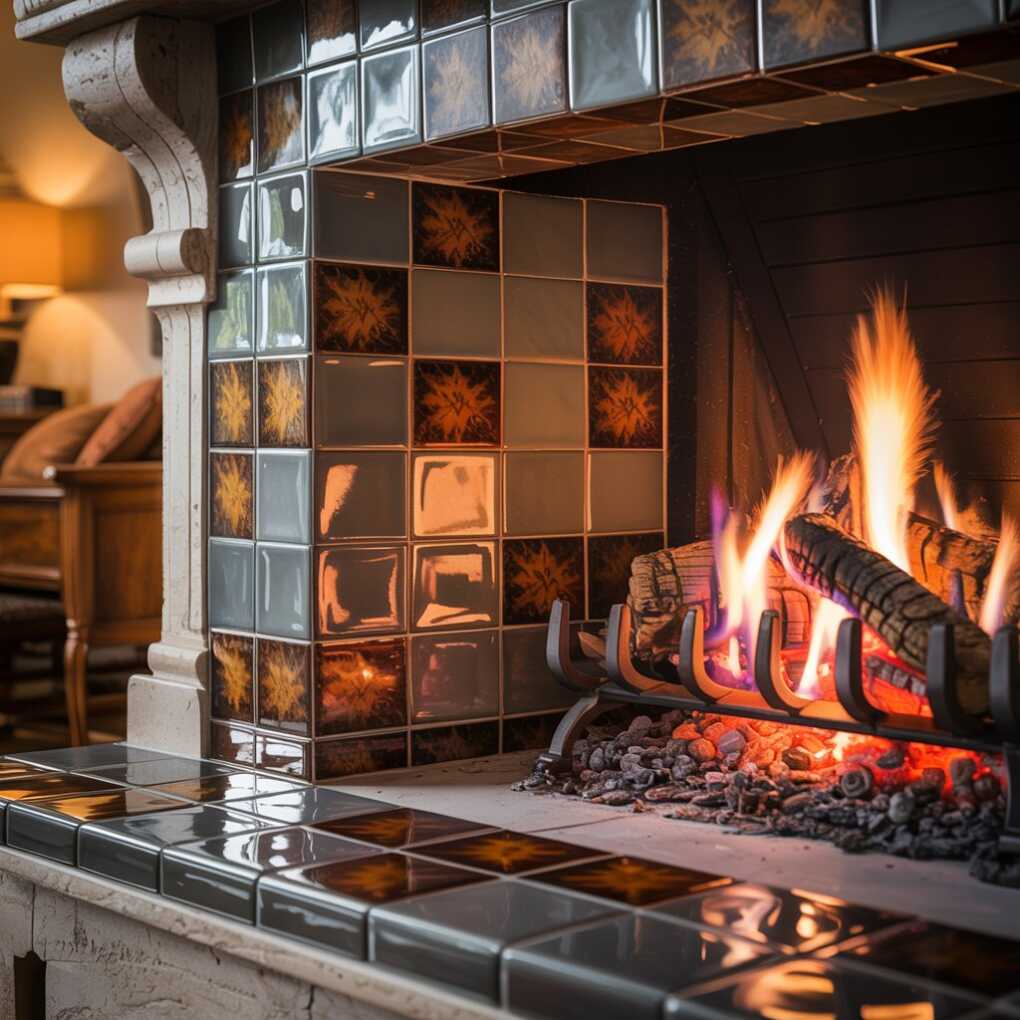Fireplace tiles have become one of the most stylish ways to update a living space. Whether you’re after a sleek modern look or a cozy traditional vibe, the right tile can turn an ordinary fireplace into the centerpiece of your home.
But before you start picking out patterns and colors, there’s one crucial question to ask: Are those fireplace tiles heat resistant?
In this guide, we’ll break down everything you need to know about tile heat resistance — from materials and safety standards to installation and maintenance — so you can create a fireplace that’s both beautiful and built to last.

Why Heat Resistance Matters in Fireplace Tiles
A fireplace isn’t just another wall — it’s a heat-generating feature that subjects surrounding materials to extreme temperatures and thermal changes. Using the wrong kind of tile can lead to:
Cracking or chipping as tiles expand and contract
Discoloration or fading due to repeated heat exposure
Safety hazards, including loosening tiles or damaged grout
Heat-resistant tiles are specifically designed to withstand high temperatures without breaking down or losing their structural integrity. That makes them not only safer but also longer-lasting and easier to maintain.
What Makes a Tile Heat Resistant?
Not all tiles are created equal. A tile’s heat resistance depends on several key factors:
1. Material Composition – Tiles made from dense, non-porous materials like porcelain and certain natural stones handle heat better than lightweight or composite materials.
2. Manufacturing Process – The higher the firing temperature during production, the better the tile can resist heat. Porcelain tiles, for example, are fired at very high temperatures, giving them exceptional strength and durability.
3. Tile Thickness – Thicker tiles can better absorb and dissipate heat without cracking.
4. Glazing and Coating – The glaze protects the tile surface, but not all glazes are heat-safe. Always check that the glaze used on your tile is rated for fireplace applications.
5. Adhesives and Grout – Even if your tile is heat-resistant, the wrong adhesive or grout can fail under high temperatures. Look for products labeled “heat resistant” or “fireplace safe.”
Best Tile Materials for Fireplaces
Choosing the right material is where most homeowners get stuck. Here’s how the top contenders compare when it comes to heat resistance and style:
1. Porcelain Tiles
Porcelain is one of the best options for fireplaces. It’s fired at extremely high temperatures, making it dense, durable, and capable of handling heat fluctuations without cracking. Plus, it’s available in endless colors and finishes — from stone-look to sleek matte styles.
2. Ceramic Tiles
Ceramic tiles are more affordable and widely available. They handle moderate heat well, especially when glazed, but may not be as durable as porcelain in high-temperature areas. They’re best suited for fireplace surrounds rather than inside the firebox.
3. Natural Stone (Marble, Granite, Slate)
Natural stone brings a timeless, luxurious look to fireplaces. These materials are naturally heat-tolerant, though they may require sealing to protect against soot or moisture stains. Slate and granite are particularly popular for their rugged beauty and resilience.
4. Terracotta
Terracotta tiles offer a warm, rustic charm. They’re naturally fired clay, which gives them good heat tolerance. However, they are porous and need to be sealed regularly to prevent cracking or discoloration.
5. Glass Tiles
While glass tiles can add an eye-catching shimmer, they’re not ideal for high-heat zones. They work best above the mantel or on walls away from direct heat exposure.
Where You Can (and Can’t) Use Tiles Around a Fireplace
It’s not just the tile material that matters — placement is key. Here’s a quick guide:
Firebox (Inside the Fireplace): Avoid tiles here. This area experiences direct flame and extreme heat. Use firebrick instead.
Fireplace Surround: Perfect for heat-resistant materials like porcelain or natural stone.
Hearth (Base Area): Needs to be both durable and heat-resistant since it’s exposed to falling embers.
Wall Above the Mantel: A low-heat zone where decorative tiles, including glass, can safely be used.
Certifications and Safety Standards to Look For
Before purchasing, check the product details for heat and strength ratings. Some important standards include:
ASTM C648 – Measures tile breaking strength, ensuring it can handle high pressure and temperature.
Temperature Resistance Ratings – Some manufacturers specify maximum temperature thresholds.
Fireplace-Safe Labels – Always look for wording like “suitable for fireplace surround” or “heat resistant up to X°F.”
Buying from reputable tile brands ensures your materials are tested for both safety and performance.
Installation Tips for Heat-Resistant Fireplace Tiles
Even the best tiles can fail if installed incorrectly. Follow these best practices:
1. Use Heat-Resistant Mortar and Grout: Standard adhesives can dry out or weaken with heat. Opt for high-temperature-rated materials.
2. Leave Expansion Gaps: Tiles expand slightly when heated. Proper spacing prevents cracks.
3. Avoid Flammable Backing: Don’t install tiles directly on wood or drywall near the firebox. Use cement board or another non-combustible backing.
4. Follow Manufacturer Guidelines: Different materials have specific installation and curing instructions. Always read the product specs.
Maintenance and Longevity Tips
Once your fireplace is installed, proper care will keep your tiles looking new:
Clean regularly using a soft cloth and mild detergent — no harsh chemicals.
Seal natural stone tiles annually to prevent stains and moisture damage.
Avoid abrasive scrubbers that can scratch glaze or polish.
Check grout periodically for cracks or gaps that may allow heat to penetrate.
A little upkeep goes a long way in maintaining both beauty and safety.
Common Myths About Fireplace Tiles
There’s a lot of misinformation floating around, so let’s clear up a few myths:
Myth 1: All ceramic tiles are fireproof.
→ Not true. While they resist moderate heat, only certain ceramic tiles are rated for fireplace use.
Myth 2: You can use any tile near a gas fireplace.
→ Gas fireplaces still produce radiant heat that can damage non-rated tiles.
Myth 3: Grout type doesn’t matter.
→ It does. Non-heat-resistant grout can crack or crumble over time, weakening the tile structure.
Conclusion
When it comes to fireplaces, heat resistance isn’t optional — it’s essential. The right tile will not only elevate your décor but also ensure safety and durability for years to come.
Before buying, always check the tile’s material, heat rating, and installation recommendations. Combine that with professional installation (or careful DIY work), and you’ll have a fireplace that’s both stunning and safe.
Whether you choose the timeless beauty of natural stone or the sleek finish of porcelain, remember: a well-chosen, heat-resistant tile makes all the difference.
